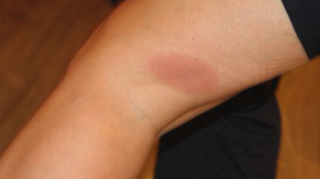Necrolytic Migratory Erythema Symptoms, Causes, Treatment
Necrolytic migratory erythema is a skin disease and a type of erythema. Erythema is a redness of skin or we can say a rash which occurs on skin surface. Necrolytic migratory erythema occurs as a result of glucagonoma syndrome. Glucagonoma is a syndrome in which a slow growing tumor is present in the alpha cells of pancreas. Glucagonoma syndrome mostly occurs in patients more than 50 years of age. It is a rare syndrome. Necrolytic migratory erythema is basically one of the symptom of glucagonoma syndrome. In glucagonoma syndrome, the tumor secrete excess amount of glucagon hormone.
Necrolytic migratory erythema is red colored rash having blisters on the surface of skin. It has the spreading capability on skin. It usually occur on the area around mouth and spread to distal extremities. Other than mouth, it may appear on ground area, lower abdomen, buttocks and perineum. Necrolytic migratory erythema is not only a symptom of glucagonoma syndrome but it may also occur as a result of intestinal malabsorption and liver disease. The diagnosis of necrolytic migratory erythema is easy as it appears on skin surface. It is an epidermal necrosis, subcorneal pustules, angioplasia of papillary dermis, epidermal hyperplasia and suppurative folliculitis.

Necrolytic migratory erythema occur on some specific region of body. Most commonly it occurs on the anal and genital regions. Other than these, it occurs on groin area, buttocks and lower abdomen and perineal region. The rash is visible but its severity fluctuates it. At the initial stage, it appears as ring shaped red colored blister, crusts or erodes. Patient feels uncomfortable due to excessive itching and pain around these blisters. After healing, these blisters leave brown colored marks on skin surface. Other symptoms may include sore smooth tongue, cracked dry lips, sore mouth and ridging of the nails.
The exact cause behind the occurrence of necrolytic migratory erythema. It may occur due to the deficiency of zinc, essential fatty acids and amino acids. It happens because tumor in glucagonoma syndrome reduces the amount of albumin protein. Albumin protein is responsible for carrying these essential elements in body.
Due to increase level of glucagon hormone in body ( in glucagonoma syndrome), the inflammation around rash increases. Inflammation also occurs on other sites of body too like the friction sites of body. Diabetes mellitus is another main symptom of necrolytic migratory erythema because of increased level of glucogon hormone.
Sclerosing encapsulating peritonitis is a skin disease, so topical medications will work a lot. Another treatment plan include surgical removal of glucagonoma tumor from pancreas. If the tumor got spread up to liver, and involve the whole liver in it, then surgery will not work.
Before surgery, a drug named somatostatin is prescribed to control the production of glucogon hormone. Zinc supplements are also prescribed. To treat tumor, chemotherapy is recommended. Chemo include dacarbazine, fluorouracil, streptozocin and octreotide. It has high mortality rate i.e. more than 50 percent people die because of it within 5 years of diagnosis.
Necrolytic migratory erythema is red colored rash having blisters on the surface of skin. It has the spreading capability on skin. It usually occur on the area around mouth and spread to distal extremities. Other than mouth, it may appear on ground area, lower abdomen, buttocks and perineum. Necrolytic migratory erythema is not only a symptom of glucagonoma syndrome but it may also occur as a result of intestinal malabsorption and liver disease. The diagnosis of necrolytic migratory erythema is easy as it appears on skin surface. It is an epidermal necrosis, subcorneal pustules, angioplasia of papillary dermis, epidermal hyperplasia and suppurative folliculitis.

Necrolytic Migratory Erythema Symptoms
Necrolytic migratory erythema occur on some specific region of body. Most commonly it occurs on the anal and genital regions. Other than these, it occurs on groin area, buttocks and lower abdomen and perineal region. The rash is visible but its severity fluctuates it. At the initial stage, it appears as ring shaped red colored blister, crusts or erodes. Patient feels uncomfortable due to excessive itching and pain around these blisters. After healing, these blisters leave brown colored marks on skin surface. Other symptoms may include sore smooth tongue, cracked dry lips, sore mouth and ridging of the nails.
Necrolytic Migratory Erythema Causes
The exact cause behind the occurrence of necrolytic migratory erythema. It may occur due to the deficiency of zinc, essential fatty acids and amino acids. It happens because tumor in glucagonoma syndrome reduces the amount of albumin protein. Albumin protein is responsible for carrying these essential elements in body.
Due to increase level of glucagon hormone in body ( in glucagonoma syndrome), the inflammation around rash increases. Inflammation also occurs on other sites of body too like the friction sites of body. Diabetes mellitus is another main symptom of necrolytic migratory erythema because of increased level of glucogon hormone.
Necrolytic Migratory Erythema Treatment
Sclerosing encapsulating peritonitis is a skin disease, so topical medications will work a lot. Another treatment plan include surgical removal of glucagonoma tumor from pancreas. If the tumor got spread up to liver, and involve the whole liver in it, then surgery will not work.
Before surgery, a drug named somatostatin is prescribed to control the production of glucogon hormone. Zinc supplements are also prescribed. To treat tumor, chemotherapy is recommended. Chemo include dacarbazine, fluorouracil, streptozocin and octreotide. It has high mortality rate i.e. more than 50 percent people die because of it within 5 years of diagnosis.
Necrolytic Migratory Erythema Symptoms, Causes, Treatment
 Reviewed by Simon Albert
on
February 20, 2019
Rating:
Reviewed by Simon Albert
on
February 20, 2019
Rating:
 Reviewed by Simon Albert
on
February 20, 2019
Rating:
Reviewed by Simon Albert
on
February 20, 2019
Rating:











